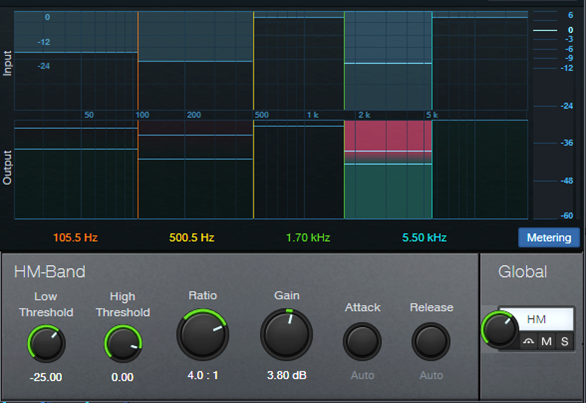Fix Mixes with Multiband Dynamics

Multiband compressors can seem daunting. However, they’re just several compressors stuffed into one plug-in (or in the case of Studio One, dynamics processors that can do more than just compression). If you know how compressors work, you’re halfway to understanding multiband compression. The other half is EQ, because each compressor processes a single frequency band. In fact, if you set the ratio controls for all to 1:1 so that there’s no compression, then the Multiband Dynamics processor turns into a “focusing” graphic EQ.
This week’s tip has two downloadable files:
- Original File.wav is included so you can experiment with the techniques in this tip. It’s part of a mixed but unmastered song (the finished version is here) that we’ll process with the Multiband Dynamics plug-in. It’s the same file used for the first audio example.
- Multiband Mix Fix.preset is the Multiband Dynamics preset we’re using. You can “reverse engineer” the settings, and experiment with making your own edits to hear how they affect the original file.
Multiband Compression and Mastering
Mastering engineers often receive mixed stereo files, so it’s not possible to change the mix. However, multiband compression can almost “get inside” the mix to change it. We’ll cover a practical example of how to use multiband compression with a mixed file.
The first step in mastering is to listen to a file several times, so that you can identify problems that need to be fixed. Here’s the file we’ll be processing.
There are three main issues:
1. The high end lacks the high-frequency “fairy dust” that’s often added to masters. Think of it like adding a pinch of salt to food.
2. The low end is weak. You can hear the bass and kick, but they don’t have enough power. This issue is especially noticeable with the bass slides between 12-16 seconds into the file, and in the downward slide at the end.
3. The upper midrange needs to be “crisper” when vocals are present, because the overall sound is a little boxy. This also affects the acoustic guitar, especially between 20-25 seconds. Finally, in the instrumental section that starts at 25 seconds, the drum attacks are too prominent. They need to be tamed so that the guitar and bass come more to the forefront.
Let’s Fix the Mix
Please note I’ve altered the Multiband Dynamics user interface artwork to include only the elements relevant to fixing the three problems above. No worries—this isn’t from some weird beta version of Studio One.
Fixing (1) is easy. The high band extends from 5.50 kHz on up (fig. 1). Although there’s no compression, the Gain control boosts the high frequencies. You could apply the same effect with EQ, but it’s more convenient with the Multiband Dynamics, because sometimes you want to make tweaks that relate to the other bands.
Fixing (2) takes a little more effort, and involves the Low and Low Mid bands (fig. 2).
The Low Band compresses frequencies below 105.5 Hz, and adds 6 dB of gain. The Low Mid band compresses frequencies between 105.5 and 500.5 Hz, and adds 5 dB of gain. This Low Mid range is where engineers often scoop the response slightly, to avoid a “muddy” sound. But this case is the exception that proves the rule, because we need more level in this range, not less.
The Mid Band applies no processing, which brings us to (3). This is the most difficult to adjust; overdo the High Mid range, and the sound becomes harsh. But without enough high mids, the sound lacks clarity.
This band covers 1.70 kHz to 5.50 kHz (fig. 3). The compression ratio is higher than the other bands, to tame the percussive drum peaks. Also, the threshold is low, and there’s almost 4 dB of gain. This gives a lift to the upper mids, and tames the drum peaks in the instrumental section.
Final Comments
The second audio example includes all the above changes. It has the same LUFS value as the first audio example, so a level difference doesn’t influence the comparison.
Note that the threshold on all the compressor’s bands is quite low. This is because the original file is around -16 LUFS. If it was higher, the thresholds wouldn’t need to be so low. The Multiband Dynamics brings the output up to around -14 LUFS. If you wanted a hotter sound, you could limit this further. But in any event, at least to my ears, the processed version sounds better than the original.
Downloads!
Download the original audio file below so you can follow along with this tip.
Download the final Multiband Mix Fix preset below. Try bypassing, soloing, and muting bands to hear what they contribute to the overall processing.


